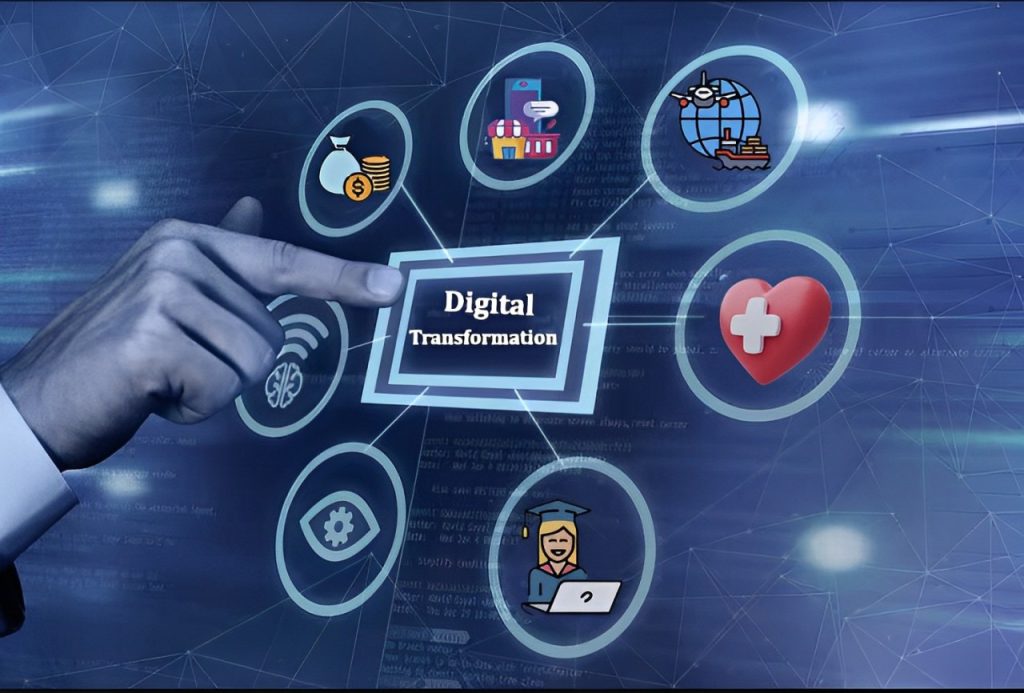Essential Steps for a Seamless Digital Transformation Journey
Every organization is trying to go digital by integrating current technologies such as computers, data, and the Internet throughout their operations.
One of the benefits of digital transformation services is better data collection and analysis.
1) Define Your Transformation Vision and Goals

The first step is determining exactly why your company wants or needs to transform digitally.
What challenges are you facing with existing processes, systems, or customer experiences?
Where are the biggest inefficiencies or missed opportunities?
Maybe you’re losing ground to competitors, struggling with data/insights, having trouble hiring tech talent, or your operations are outdated.
Clearly define the issues you aim to resolve and prioritize the most important goals and outcomes you hope to achieve through transformation.
Do you want to automate more processes, improve data analysis, upgrade customer service, and boost efficiency and innovation? Get specific and make sure leaders are aligned.
The digital transformation process involves using new technology to change how a business operates.
Having this transformational vision and measurable objectives up front provides organizational focus.
Additionally, you need to estimate the potential costs, resources, and timeline required to achieve your transformation vision.
Work with finance to model out costs for new technologies, external support, hiring, training, and more. Identify sources of funding or cost optimization opportunities.
Getting buy-in and budget commitment from the start is crucial.
While transformation provides ROI long-term, the initial investment can be substantial, so proper due diligence upfront is wise.
To start your digital transformation journey, first, understand why you need to change.
Some additional key activities for this step include:
- Conducting stakeholder interviews across the business to capture diverse perspectives
- Benchmarking your current capabilities against competitors and best practices
- Building a compelling change story to socialize the “burning platform” for transformation
- Outlining high-level guiding principles, use cases, and scope parameters
Digital transformation examples include using online platforms for sales and marketing to reach more people.
2) Assess Your Current State and Readiness

Next, you need a clear picture of where your organization stands today across processes, technologies, data, skills, and culture before trying to transform.
Conduct a comprehensive audit examining:
- Business workflows, existing systems/tools, integrations, IT infrastructure
- Data sources, data management practices, analytical capabilities
- Employee skills and talent gaps, especially in digital areas
Understand what’s working well that you can build upon versus outdated or broken things to replace or improve. Look at roles, decision processes, teams, policies, governance structures, budgets, vendors, and more.
It’s also critical to evaluate organizational readiness and capacity for change.
A successful digital transformation process requires clear goals and strategies.
How willing are employees to adopt new ways of working? Do leaders have the resolve to drive transformation?
Getting an objective readiness assessment surfaces potential roadblocks early.
The current state assessment should map out dependencies between processes, technologies, and capabilities.
This highlights the domino effects of changing certain elements. You need to find a balance between reusing or extending current investments versus ripping and replacing them.
An open and transparent inventory makes the impacts of transformation clear from the outset.
Some businesses have implemented digital transformation examples like using mobile apps for customer service and support.
Some key activities here include:
- Conducting maturity assessments across core capabilities like data, cloud, automation, cybersecurity
- Mapping out process flows, application portfolios, and system architectures
- Documenting skills inventories and gaps compared to target digital skill
- Deploying surveys and focus groups to gauge organizational change appetite
An important benefit of digital transformation is the ability to adapt quickly to changing market trends.
3) Build Your Transformation Strategy and Roadmap

With defined goals and a clear understanding of your current state, you can start developing a holistic, multi-year strategic plan outlining the digital transformation roadmap for your organization.
This plan should lay out prioritized workstreams and initiatives like:
- Modernizing technology platforms, infrastructure, and applications
- Optimizing business processes through digitization and automation
- Establishing advanced data, analytics, and AI/ML capabilities
- Enhancing digital skills, talent strategies, and the digital workplace
- Improving user experiences and customer engagement models
- Implementing change management, leadership, and governance
E-commerce platforms are prime digital transformation examples that have revolutionized how businesses sell products and services online.
Prioritize based on organizational impacts, dependencies, and capacity. Outline when new digital practices or technologies will be rolled out and operationalized.
Establish a clear transformation program management structure with leaders, initiative owners, SMEs, and cross-functional teams working in an iterative, agile approach.
Ensure robust governance, decision-making, and accountability processes.
Continuous evaluation and adjustment are necessary parts of the digital transformation process.
The roadmap should strike a balance between “quick wins” to build momentum and more ambitious, long-term transformation plays.
Expect to adjust as you go based on results, feedback, and evolving conditions.
But having a cohesive multi-year strategy prevents disjointed efforts. Stay focused on business capabilities rather than just technologies.
Additional key steps include:
● Developing a comprehensive change management and communication strategy
● Mapping out sequences and dependencies between initiatives using road mapping tools
● Defining funding models, implementation budgets, and financial governance
● Establishing initiative scorecards, KPIs, and targets to track progress
4) Create Technology and Data Foundations

With the transformation strategy defined, you can start modernizing the core technology and data foundations required to enable digital capabilities across the enterprise.
On the technology front, this could involve initiatives like:
- Migrating to cloud platforms and modern IT infrastructure
- Upgrading networks, cybersecurity, devices, and end-user computing
- Deploying platforms for automation, analytics, AI/ML, IoT, and integration
- Modernizing legacy applications and adopting SaaS application suites
- Implementing low-code tools for rapid digital innovation
In parallel, you need to establish advanced data management and intelligence capabilities by:
- Consolidating and integrating data across sources into data warehouses/lakes
- Establishing data governance, quality, standards, and metadata programs
- Building out self-service BI, reporting, and data visualization tools
- Deploying advanced analytics, data science, and AI/ML modeling workbenches
- Implementing master data management and data-sharing architectures
By prioritizing these technology and data backbone projects upfront, you create the foundations to scale digital capabilities across the enterprise.
As new platforms are implemented, make sure to prioritize integration between systems and data sources from the start.
Hybrid landscapes across cloud and on-premises will be the norm.
Establishing an agile, API-driven integration architecture prevents recreating data silos.
Continuously modernize to stay current while decommissioning technical debt.
Additional activities include:
- Defining target reference architectures and technology roadmaps
- Standing up cross-functional IT “SWAT” teams to drive implementation
- Establishing agile release management and DevOps processes
- Formalizing policies and standards for technologies like cloud, data, cybersecurity
5) Drive Adoption through Change Management

Even with the best-laid plans and technologies in place, digital transformation is a massive change for any organization and its employees.
That’s why proactive change management is critical.
From day one, you need to overcommunicate the overall transformation vision and “why” behind the effort.
Describe the future state you’re working towards, and share progress, wins, and success stories.
Help employees understand “what’s in it for them” and how it will make their jobs more productive.
Comprehensive training and upskilling initiatives ensure employees fully leverage new tools, adopt desired processes/behaviors, and develop essential digital skills like data literacy.
Combine formal programs with on-the-job coaching, learning platforms, and knowledge sharing.
Incentives, goal alignment, role mapping, and revised policies institutionalize digital-first mindsets.
You’re driving widespread adoption and a cultural shift – not just implementing technologies. Leadership reinforcement of the desired digital culture is key.
Of course, talent strategies are vital – from hiring digital talent to retraining and career path planning for people in obsolescing roles.
Esignatures can significantly improve the efficiency of these strategies, particularly in streamlining the recruitment and contract management processes, ensuring a smoother experience for both employers and candidates.
Consider gig/crowdsourced models to access digital skills. Invest in change champions and cross-functional transformation enablers.
Change saturation is a real risk, so pay close attention to adoption levels. You may need to adjust change plans based on receptiveness.
Celebrate successes but also gather continuous feedback to correct course. Change is never a one-and-done task during transformation – it’s an ongoing journey as you continue evolving.
Additional key activities include:
- Launching transformation communications hub, blogs, videos, town halls
- Developing tailored training curriculums and learning journeys by role
- Updating policies, incentives, goals, and metrics to reinforce behaviors
- Closely monitoring adoption metrics and resistance points
- Proactively identifying and enabling grassroots change champions
Start your digital transformation journey by identifying areas where technology can make a difference.
Conclusion
Digital transformation is a massive undertaking requiring significant investments in time, resources, and commitment across all levels of an organization. Following these 5 key steps provides a crucial roadmap for incrementally planning, building, and adopting digital capabilities.
It’s an iterative process that evolves as you make progress and pivot based on results, learnings, and market changes.
However, by carefully sticking to a planned method, you increase your chances of transformation success.
What has been the most difficult challenge your firm has experienced thus far on its digital transformation journey? Let us know in the comments below!
FAQs
1) What problems do companies face when they try to transform digitally?
Companies might have trouble getting people to accept change, making different technologies work together, keeping things safe from hackers, and finding enough people who know how to use new technology.
2) How can small businesses start their digital journey?
Small businesses can start by finding where new technology can help them the most. They should pick things that match their goals, budget, and what they’re good at. They might also ask for help from experts or use easy, cheap technology from the internet.
3) Why is leadership important in digital transformation?
Leadership is vital because it helps set clear goals, make sure everyone agrees, find enough money, and show others how to change. Good leaders make sure everyone in the company works together and solves problems.
4) How do companies keep data safe during digital changes?
Companies keep data safe by using strong locks, like passwords and special codes. They also follow rules about privacy and tell everyone how they’re keeping things safe.
5) What is digital transformation?
Digital transformation is the integration of contemporary digital technologies across all aspects of an organization to radically alter how it runs and provides value to consumers.
It entails modernizing and automating procedures, expanding data capabilities, improving consumer experiences, and developing digital operating models.
Read More:



